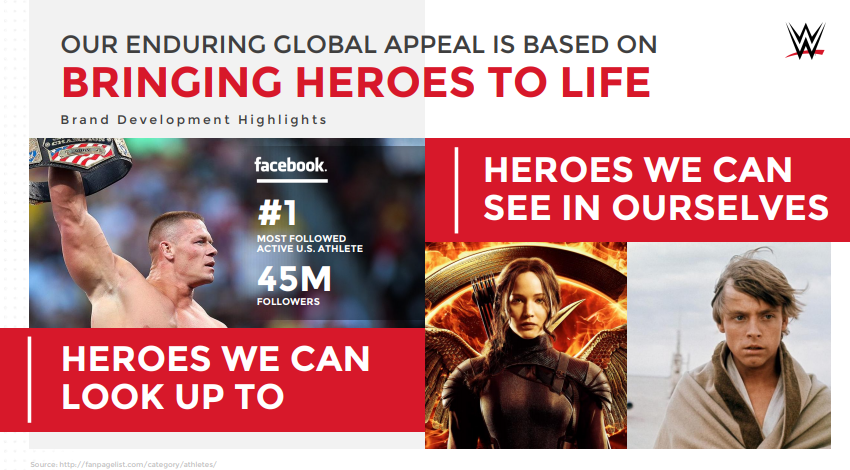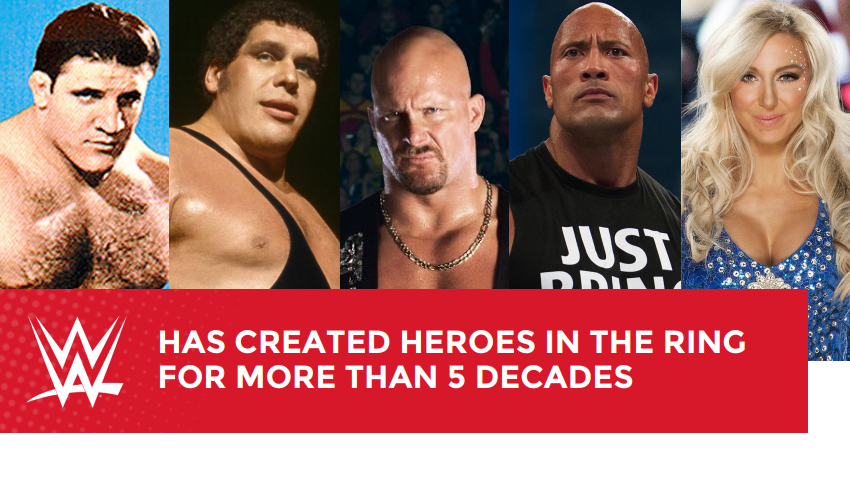The most influential person in the pro wrestling industry that almost no one knows about, George Barrios, is in conference season again. Since December 8, he’s given three talks at different locations around the country that were webcast on WWE’s corporate website.
“If my boss were here, man, you guys would be in big trouble,” Barrios quipped as his talk at the TMT West Conference in Las Vegas was to start on January 8, being jocular to probably some tech people, emphasis on his utterance of “big”, as it seemed presentation equipment was being fussed with.
Barrios is Co-President of WWE, whose former title was Chief Strategy and Finance Officer. Along with other Co-President Michelle Wilson, they’re the top corporate officers in the company under CEO Vince McMahon.
Barrios almost completely evades the view of wrestling news outlets -- who otherwise comb through every shred of information, every high-impression tweet, tangentially interesting Instagram post, and every clickable tidbit that gets upvoted on Reddit. Maybe that’s because the subject matter Barrios talks about isn’t click-baity enough or because it’s too abstruse to easily transcribe and distill into a 250-word article shrouded in interstitial ads and flanked by banners for bizarre news stories seemingly dispatched from a parallel universe. Amid the great fight for eyeballs, i.e. consumer attention -- a fight Barrios himself explicitly says WWE is engaged in -- the content the Queens, NY native himself appears in isn’t that popular, even while the business strategy described therein greatly underpins the industry otherwise covered down to the last trivial detail by the wider wrestling media.
Only audio of these conference talks is made publicly available. We’re left always to imagine Barrios (wielding millionaire hairstyle and personally holding 345,322 shares in WWE stock awards) strolling around a well-lit auditorium stage with PowerPoint remote control in hand, pointing at a big screen of slides and gesturing as he pitches the biggest wrestling company in the world as a partnership and investment opportunity to non-wrestling fans sitting in rows of forward facing spring-loaded cushy upholstery seating.
George Barrios’ wrestling history
At these conferences he goes through his routine of outlining the fiscal might of WWE as a media company. Barrios doesn’t appear to have been the most avid wrestling fan before coming to Titan Tower in 2008. He previously worked for firms like The New York Times, Praxair and HBO. He’s made gaffes in years past like saying his favorite modern wrestler is “Shawn Rollins” and favorite all-time wrestler is “Ricky ‘The Steamboat’ Dragon” that suggest something about his fandom. But let’s not keep the gate from a corporate executive who received more than $10 million in compensation between 2015 and 2017. To be fair, of late Barrios seems to have brushed up on wrestling history. Maybe not enough to host his own wrestling podcast on the Pioneer Era yet, but he’s made reference to the 100-year age of the industry. And he’s able to put WWE business in a sensible historical context.
WWE business is now in its “third iteration,” Barrios says.
“The business was started by our CEO, founder, Vince McMahon when he bought it from his father, 35 years or so [ago],” Barrios explained at the TMT Conference, referring to Vincent K. McMahon taking over the company in 1982 at the twilight of the Territory Era. “And it was a Northeast touring business, so it made money only one way really: selling tickets to events in the Northeast.”
“The first transformation was Vince essentially rolled up North American professional wrestling.” Vince went national and took over venues and television outlets of other promotions around the country.
“So it went from Northeast touring to U.S. touring.”
“Pay TV springs up around the world,” Barrios narrates, “and [WWE] goes from a U.S. touring business to a global media business. The content begins being spread around the world. We're now in the third iteration of re-imagining WWE which is this social, digital, direct-to-consumer transformation. So it's something we've done over and over. We're just in the early innings of the latest re-imagination.”
Indeed WWE’s ticketing business, while still the #3 revenue driver, in Q3 was barely profitable against declining attendances. The overwhelming majority of WWE’s profitability now is driven by selling video: mostly TV rights to Raw and Smackdown, followed by Network subscriptions.
No update on overdue UK TV deal
WWE signed increases for its U.S. TV rights at an impressive rate of 3.6x last year, leading to the company’s stock price skyrocketing. Renegotiations for new deals with the company’s #2 and #3 biggest TV partner regions, the U.K. (current partner, Sky) and India (current partner, Sony), are still underway. The year ended with no new U.K. deal announced, so we’re now past the time when Barrios told investors to expect the news.
Barrios was questioned by an audience member in Las Vegas if there was any update he could give on either deal but he declined. However when asked about viewership metrics he admitted the decline in WWE viewership in the U.K. was greater than that of viewership in the U.S.
“The viewership [for WWE Raw and Smackdown in the U.K.] saw declines similar to in the U.S. Over [the last five years] in the U.S. we were down about 30%. The consumption in the U.K. in total, about that range, maybe a little bit bigger decline but in that ballpark.”
The wrestling philosophy of George Barrios
In New York City on Tuesday at the Needham Conference, perhaps measuring he was in front of an audience even less familiar with pro wrestling than usual, Barrios went into his pitch to explain WWE’s global popularity to the unacquainted. This along with other points he made at Needham we might think of as Barrios’ wrestling philosophy, his understanding about why and how pro wrestling (or at least WWE’s version of it) connects with such a wide range of people across regions, languages and backgrounds.

WWE Investor Presentation TMT 2019, page 10
- The ring: Barrios tells us cricket is hard to understand, especially if you didn’t grow up with it in India. American football is hard to understand if you didn’t grow up with it in the U.S. But the ring, when you see two combatants enter the ring, everyone understands what’s about to happen. In pro wrestling there aren’t a complex set of rules that take a lot of time for viewers to learn.
- Hero’s Journey: Otherwise known as the monomyth, Joseph Campbell’s template explaining how storytelling works is a favorite for Barrios. A hero emerges and faces adversity. This explanation allows him to compare heroes like John Cena to Star Wars’ Luke Skywalker and The Hunger Games’ Katniss Everdeen.
- 3 media platforms, each with different content: Barrios stresses that although WWE produces a lot of content for three different major types of platforms (pay TV, subscription video streaming and ad-supported video streaming), the company puts different content on each platform. WWE doesn’t release the same content across the platforms, so he says. There’s truth to what he’s saying, even if episodes of Raw and Smackdown that air live on pay TV do end up on the WWE Network 30 days later and clips of each program’s segments appear on YouTube and Facebook within hours of their original airing.
- 3 big growth opportunities for WWE:
- Increased value of content: Whether it’s through further leveraging the value of TV rights fees and getting another big increase in the next round of deals for Raw and Smackdown in another five years, or through selling content at a premium on other platforms, the hope is that live sports-like programming like that which WWE has lots of will continue being increasingly valuable in the years to come.
- Data/customized marketing: WWE now has millions of user accounts with a lot of data connected to those accounts, including customers’ Network viewing activity, purchasing activity of merchandise through WWEShop and, somehow, their ticket purchase preferences (even though ticket sales are largely handled by outside vendors like Ticketmaster). In a future with big data, Barrios believes they will continue to send customized messages to fans based on their apparent preferences, and says they already are sending targeting emails to users based on who they think their favorite wrestlers are based on activity.
- International growth opportunity: 70% of WWE revenue today comes from the U.S., 30% from outside the U.S. However 70% of video consumption comes from outside the U.S. This represents a “long tail wind” Barrios says in business speak, while admitting this will take time as emerging markets like India, China and Brazil grow their middle class.

WWE Investor Presentation TMT 2019, page 36
Overall these ideas are a modern vision of how WWE can manage its brand and seize new media business opportunities, to “re-imagine” its current strategies, be self-disruptors (as in the case of the WWE Network launch), use big data to all but force you to consume the valuable content.
Maybe Paul Heyman said this somewhere: there are two big conditions needed to do big business in the wrestling industry: distribution and talent. You need a strong media presence (usually a TV program on a widely available TV channel) and stars that connect strongly with an audience.
Despite Barrios’ apt presentation of the monomyth and his slide that shows faces of stars across the generations -- Bruno Sammartino, Andre the Giant, Steve Austin, The Rock and Charlotte Flair -- it’s not clear the Co-President understands star creation. One might gather from these talks that star creation is somewhat inevitable and Charlotte Flair (or pick your favorite current WWE wrestler) is every bit the culturally transcendent star and drawing card that the other four were.

WWE Investor Presentation TMT 2019, page 11
Presentations like these are for non-fan audiences, so questions that penetrate into whether Barrios understands the importance of star power doesn’t come up. If one didn’t know better, you get the impression that WWE is this powerful media company that more or less produces widgets, produces uniform, rather interchangeable wrestling content that thanks to the ring and the monomyth is eaten up across the globe.
Is the message that the brand is in fact more important than any star? Is transcendent, business-moving star creation just too risky for a public company because it gives one talent too much leverage and presents uncertainty in the case of that star’s absence or departure? What is the creative vision of WWE? Is it something more than “putting smiles on people’s faces”?
While distribution of WWE content is secure, stars are not inevitable. Nor is goodwill with its audience. And while the value of WWE’s video content is ever-increasing, disproportionate opportunities for other companies like New Japan Pro-Wrestling and even new companies like All Elite Wrestling are emerging where WWE’s moat should be dug so deep it should be impossible to serve an unsatisfied portion of the Western and global wrestling audience.
Brandon has been writing about the wrestling business since 2015. He’s an independent pro wrestler, wrestling trainer, and co-host of the podcast Wrestlenomics Radio.




